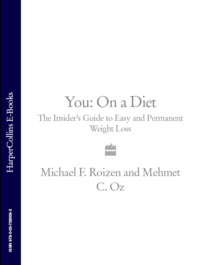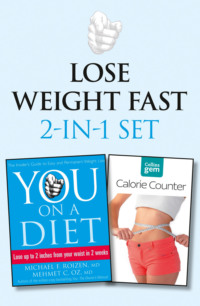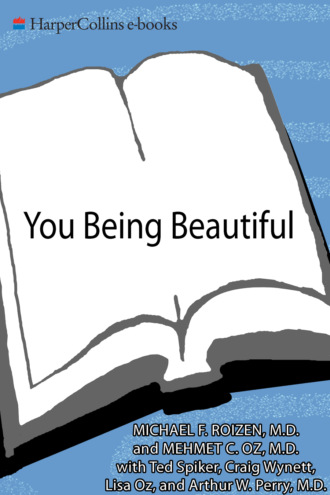
Полная версия
You: Being Beautiful: The Owner’s Manual to Inner and Outer Beauty

You Being Beautiful
The Owner’s Manual to Inner and Outer Beauty
Michael F. Roizen, M.D. and Mehmet C. Oz, M.D.
with Ted Spiker, Craig Wynett, Lisa Oz, and Arthur W. Perry, M.D.
Illustrations by Gary Hallgren

To all who radiate outer beauty
because they treasure inner beauty
NOTE TO READERS
This publication contains the opinions and ideas of its authors. It is intended to provide helpful and informative material on the subjects addressed in the publication. It is sold with the understanding that the authors and publisher are not engaged in rendering medical, health, or any kind of personal professional services in the book. The reader should consult his or her medical, health, or other competent professional before adopting any of the suggestions in this book or drawing inferences from it. For medicine and herbal supplements, remember that herbals and nontraditional medicines can have side effects with traditional medicines and even foods. Pregnant and nursing moms should check with their doctor and pharmacist about these, and even traditional medicines.
In addition, this book sometimes recommends particular products or websites for your reference. Drs. Oz and Roizen are not affiliated in any way with such products or entities (with the exception of the Real Age website). In some instances, other coauthors or contributors may be affiliated with a referenced product or website, but recommendations were made independent of such affiliation. In all instances, bear in mind that there are many products or websites other than those recommended here that may work for you or provide useful information to you.
The authors and publisher specifically disclaim all responsibility for any liability, loss, or risk, personal or otherwise, which is incurred as a consequence, directly or indirectly, of the use and application of any of the contents of this book.
CONTENTS
Cover
Title Page
Note to Readers
Dedication
Introduction
Your YOU-Q: Measure Your Inner and Outer Beauty
Part I: Looking Beautiful
1. In the Flesh: Make Your Skin Glow
2. Head of Class: How to Save Your Hair
3. Oral Victories: Your Mouth and Teeth Are a Portal to Your Inside—and Say a Lot About Your Outside
4. Digital Revolution: Shape Up Your Hands and Feet
5. Great Shape: How to Get the Body You’ve Always Wanted
Part II: Feeling Beautiful
6. Energized and Revitalized: Power Up Your Body by Resetting Your System
7. That’s Gotta Hurt: How to Manage Your Major Aches and Pains
8. Get in the Mood: What You Can Do to Straighten Out Your Mind
9. The Worry War: Solve Your Most Troubling Job and Money Issues
Part III: Being Beautiful
10. That Lovin’ Feeling: Improve Your Relationships with the People Close to You
11. That’s the Spirit: How to Find True Happiness
The Be-YOU-tiful Plan: Live the Ultimate Beautiful Day (and Improve Your YOU-Q)
YOU Tools: More Strategies for Helping You Become Even More Beautiful
Appendix: Healing with Steel - Finding the Right Plastic Surgery for You
Searchable Terms
Acknowledgments
Other Books by Michael F. Roizen and Mehmet C. OZ
Copyright
About the Publisher
YOU Tools
The Ideal Wash
Body Art
Hair Care
Foot Play Foreplay
Fashion Statements
Orthopedic Injuries
Breathe-Free Program
Finding Your Personality
Green Living
The Band Workout
The Yoga Workout
The Perfect Gym Bag
Health Utensils (Your Medicine Cabinet, Home Hygiene, Infection Protection)
Your Eyes
The Biophysical Battery: Energy Blood Tests
INTRODUCTION
For those of you who think beauty is about mirrors, makeup, and how many pudding packs you have to sacrifice to fit into your skinny jeans, then pull up a chair, postpone your top-of-the-hour Botox appointment, and hear this.
Beauty isn’t some vapid and superficial pursuit that exists solely to sell products, wag tongues, and produce drool. Beauty is actually precisely perceived, purposeful, and rooted more in hard science than in abstract and random opinion. From the time we started prancing around the world with our body-hair parkas and leafy lingerie, evolution has pushed us to be more beautiful. And that’s why beauty serves as the foundation for our feelings, our happiness, and our existence. In fact, beauty doesn’t reflect our vanity as much as it does our humanity.
Beauty—dear appearance-obsessed friend—is health.
We already know that beauty is always on your mind, because it’s on everyone’s minds. You can’t help but think about it or suppress it—consciously or not—every time you step in the shower or in front of the mirror. It drives many of the decisions you make about exercise and eating, and it determines how you choose between the black dress and the white pants.
This kind of traditional beauty—the outer kind—really isn’t just about looking good. Outer beauty serves as a proxy of how healthy you are; it’s the message you send to others about your health.* Way back when—before we could decode your genome, use fertility tests to see when you’re ovulating, and order MRIs to see what was going on with your liver—people used beauty as the serious assessment of the potential health of a partner. Beauty was the best way to figure it out (and in a tenth of a second, mind you). Now, if you take the concept of beauty a few steps deeper, you realize that inner beauty—the idea of feeling good and being happy—also has tremendous health implications in every aspect of your life.
But for so long, we’ve had it all wrong. We’ve thought of beauty as nonessential and superficial. Just look at our most popular beauty-based clichés:
Beauty is in the eye of the beholder. Translation: Just as we all have different taste buds, we all have different beauty buds, as well. Some like blond; some like brown. Some like their men to wear boxers; others prefer leopard-print G-strings.
Don’t judge a book by its cover. Translation: Don’t make assumptions or judgments about people just because they have big boobs, no hair, or a belt that’s longer than a circus tightrope.
Beauty is only skin deep. Translation: Stop linking outer beauty with the inner kind. They’re as separate as mashed potatoes and maple syrup.
The logic behind all these myths argues that external beauty is unimportant, most likely misleading, and at best relevant only until more useful information becomes available. But we have three words for these three clichés: wrong, wrong, wrong. Scientific study after study shows that these popular principles are more myth than reality.
In fact, research shows that human beings have evolved universal standards of beauty, both within and across cultures. Research also shows that attractive people are judged more positively than unattractive people—even when there’s other information available about them. The data show that more attractive people are judged to be better liked, more competent, and more exciting (all by about a two-to-one margin). Research also indicates that external beauty is linked to personality and behavior.*
Though there are biological and social influences on beauty, it does seem that being deemed attractive creates a kind of self-fulfilling prophecy that reinforces and internalizes certain behaviors and self-concepts. And guess what? Most of these crucial factors are ones you can change for the better.
In YOU: Being Beautiful, we’re going to share with you the biology of beauty, as well as what you can do to be your most beautiful self by making choices and taking actions that will help you look the way you want, and most important, feel and be the way you want.
We’re going to clarify what beauty really is—and give you the tools to become healthier and happier by paying a little more attention to it. How? We’re going to chop up beauty into three distinct pieces—pieces that will give you a perspective that may change the way others view you and, ultimately, the way you view the world. These three hunks serve as the structural outline for this book.
Part 1:
LOOKING BEAUTIFUL: You don’t have to be a screen star to know that outer beauty matters. Simply, appearance is the proxy—the instant message to others—for youth, fertility, and health. In this section, we’ll explore some of the ways that you can improve your looks when it comes to such things as your skin, your hair, and your body shape. Most of all, these things are important because how you look partly helps determine how you feel.
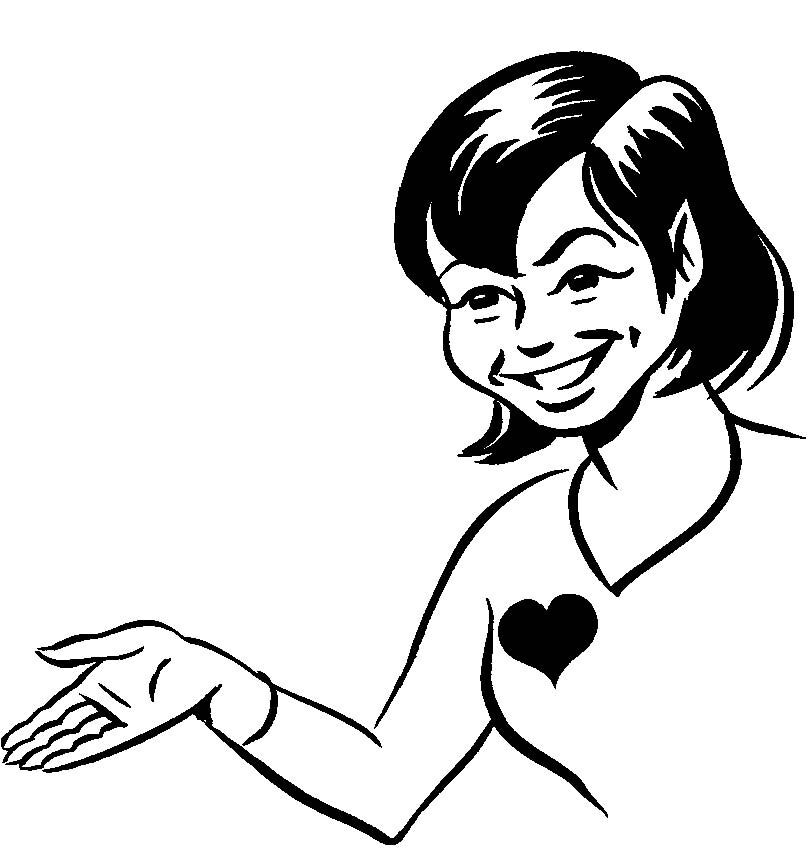
Part 2:
FEELING BEAUTIFUL: There’s no doubt in our minds that looking like diamonds doesn’t mean squat if you feel like a wooden nickel. You can have the best hair, skin, and butt this side of Kalamazoo, but if you lack energy or your knees creak or you’re sadder than a leashed kitty, then all the outward magnetism you may have will be obscured—and fade fast. Here we’ll take a look at the big things that can keep you from feeling beautiful—things like fatigue and chronic pain and destructive attitudes—so you can help turn the blues into, well, hot pinks or purples.
Part 3:
BEING BEAUTIFUL: Though you may assume that we’d be imposing morality in a section about “being beautiful,” we’re not really talking about behaviors here. We’re not here to tell you what’s right and wrong but to explain how to take your life one step deeper—to find a more authentic and happier you in your life and relationships—and how to use different strategies to do so.
The beauty of these three kinds of beauty is that they’re all tied together: Looking as good as you like helps you feel good about yourself, which serves as the foundation for developing that sense of authenticity and deeper purpose that so many of us crave as we search for meaning in our lives. Plus, being authentic and happier makes you physically more attractive.
Now, let’s get one thing straight so you can relax a bit. You wouldn’t be here unless your ancestors were beautiful. You need to accept the fact that we’re all beautiful; sexual selection guaranteed it, because your ancestors mated with the most beautiful partners. We all have beautiful elements in us; we’re going to talk about ways that we can expose and maximize them.
The beauty industry is one of the biggest money-takers around (it sells us a lot). We have cosmetics companies and cosmetic surgeons. We have super-models with their own magazine covers, commercials, and reality shows. We’re obsessed with fashion and our weight. We fret over inopportune pimples in inopportune places. We exercise our bodies, we scrub our faces, we wax off gnarly hair, we buy expensive underwear to push our breasts up and suck our stomachs in. And maybe you’re right. We’re all emphasizing the wrong things.
Here we argue that beauty is also much more than outer appearances alone. As we’ll explore through the middle and the end of the book, beauty is also about how you feel and how you define your life. These three interlocking elements—look, feel, be—work together to form what we believe is the ultimate goal in all of our lives: to feel good about yourself because you have strong self-esteem and a healthy, energetic existence that allows you to appreciate the subtle beauty of day-today life, and because you know your purpose in life—and to show off that purpose by helping others do the same.
YOU: Being Beautiful is really about the fact that we’re all hardwired with automatic thoughts and perceptions about beauty. That means that many of these ideas have evolved over thousands of years to form a foundation for human behavior, emphasizing that it’s especially hard to overcome some of the automatic drives.
To that end, beauty is very serious business—as in survival-of-the-species serious. When we think about survival of the species (living long enough to pass your genes on to the next generation), it’s natural to emphasize the survival part of the equation. But when it comes down to a choice between surviving and breeding, breeding often wins. (Think of male grizzlies fighting to the death for a mate.) Considering the stakes, you’d better be sure that the object of your affection (that man with those magnificent abs) is worthy of the effort to attract him. But how can you know for sure? Thankfully, just like the metal detector–toting treasure hunter who leaves luck and serendipity to the amateurs, you come fully equipped with your own professional-grade beauty detectors.
When we spot a particularly attractive person, somewhere deep in our reptilian brains, a beauty alarm goes off. It tells us when we’ve struck gold, and it does so automatically and subconsciously. Just like a reflex, it’s automatic, impossible to stop, and Annie Oakley accurate. Your beauty detectors have the mathematical precision of a Swiss watch, and this precision comes in the form of some very specific numbers that you’ll learn about in this book, including something called the Fibonacci sequence. You’ll also learn that’s the reason why we make so many decisions with our emotions and not our logic; those decisions play a major role in how beautiful and healthy we feel.
To teach you about these things, we’re going to use some of the same techniques you may be familiar with if you’ve followed us along this wonderful journey about YOU. We’ll offer YOU Tests to allow you to assess your various states of beauty. We’ll explain (both verbally and visually) all of the biology that makes up the systems we talk about; once you know the why, you’re more likely to take action with a what. We’ll offer plenty of YOU Tips and YOU Tools that you can use to look and feel better than you ever have before. Right after this introduction, we’ll test your YOU-Q—a measurement of how well you’re doing in your overall pursuit of authenticity and happiness, since there’s quite possibly a large difference between the current you and the potential you (it’s hard to be happy if that difference is big). And we’ll end up with the ultimate beautiful day—24 hours of simple changes that can help you get where you can.
Along the way, you’ll be challenged, shocked, and surprised—and your perceptions about inner and outer beauty may very well implode right in front of your freshly exfoliated face. You’ll learn why shampoo may not be all that necessary, why and how the perfect smile can be measured down to the millimeter, how a secret to effective foreplay centers around your ten toes, why female orgasms are crucial to the continuation of the species, how tennis balls can mend an aching back, why a simple change in language fosters or stops addictions, and why our definition of spirituality is like nothing you’ve ever heard before. We’ll cover lots of topics in these three parts of beauty—including all the health implications and easy-to-follow solutions that can help you get the most out of life. (In our humble opinions, it doesn’t get more beautiful than that.)
As you dive into this book, you’ll come across essential information about the seemingly inconsequential things in life (hello, pores!), and you’ll come across mind-blowing inspiration about the absolutely consequential things in life (how to find true meaning and purpose). While we’ll hit you with the nuts and bolts of outer beauty, we also hope to inspire you to make changes about how you feel on the inside. Throughout, we’ll try to challenge your assumptions about what true beauty is.
Along the way, you’ll surely look in the mirror—both literally and metaphorically. You’ll get new perspectives on body shapes, on fingernails, on tongues, on depression, on knee pain, on energy levels, on sexuality, on prayer, on so many things in your life that you can strengthen to live healthier and happier. It may be hard to imagine that hangnails and deities belong in the same book. But as we hope you come to appreciate, beauty isn’t about the parts. It’s about how those parts work together to form the whole. The whole YOU.
YOUR YOU-Q
Measure Your Inner and Outer Beauty
In this book, we’re going to give you lots of advice about things you can do to look, feel, and be more beautiful. Some of them you should absolutely do, because they contribute to your overall health. Others? They may not be so clear-cut, because, unlike flip-flops and baby cribs, they’re not a one-size-fits-all proposition. What works for you may be absolutely wrong for someone else.
To that end, we’ve developed the ultimate YOU-Q Test—a quick exercise that will help you identify the things that can help you become happier and more satisfied with yourself. And your life. The key to all of it: finding what we call authentic beauty. True beauty comes when you engage with your fellow man in a healthy fashion. That’s real authenticity and what will make you happier.

Authentic beauty comes from closing the gap between the Current YOU and the Potential YOU.
Current YOU (who you are right now): This includes your physical appearance (bunions and all) and all of the characteristics and quirks that make you, you.
Potential YOU (the person you would like to be, remembering that that may not be the perfect person): Current YOU with some adjustments—perhaps a bit thinner, a little more empathetic, a better cello player, maybe even a redhead.
When the gap between Current YOU and Potential YOU is wider than a 12-lane interstate, you’re going to feel less beautiful, less satisfied, and less confident. Close the gap, and bingo, you’re hitting the bull’s-eye on the target of authentic beauty.
No IQ test or SAT or insect-looking inkblot can help you identify the size of your gap. This YOU-Q Test will. The YOU-Q tests the nature and size of your gaps in four major areas—and gives you plenty of issues to ponder. But don’t think of this as a final exam. Think of it as more of a practice test that you can retake and retake and retake until you come as close to perfection as possible.
As you read the book, your test results will help you understand where to focus your attention in order to bring Current YOU and Potential YOU into better alignment to find true happiness. To help you along the way, you’re going to record your scores on the YOU-Q report sheet at the end of the chapter. OK, sharpen your No. 2 pencils and let’s begin.

Note: All the questions in this test are based on validated studies, i.e., real docs spent years proving that these are the appropriate questions to ask to get accurate answers to help you understand yourself. We even enlisted the help of world expert psychologist Dr. Art Markman from the University of Texas to ensure accuracy.
Part I: Looking Beautiful
Think about the appearance you present to the outside world—your face and body. Using the figure below, answer these two questions (be honest, bucko, nobody’s looking but you):
1 Circle the image that most closely corresponds to the body type you have right now.
2 Circle the image that represents what you think would be the ideal body type for you. This body type should be the one that you want, not the one that you think others might want for you.
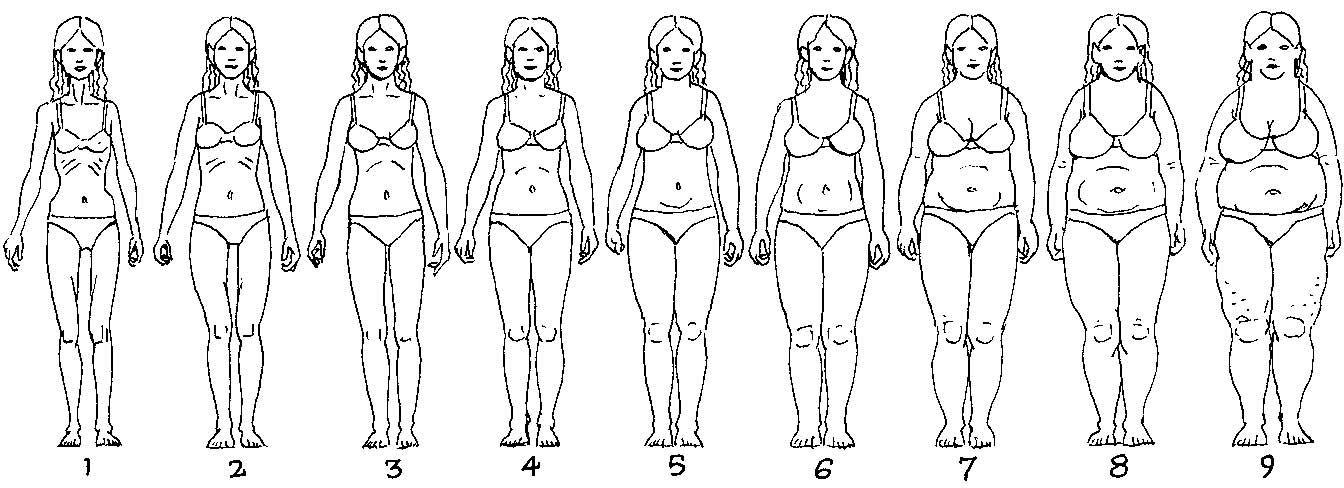
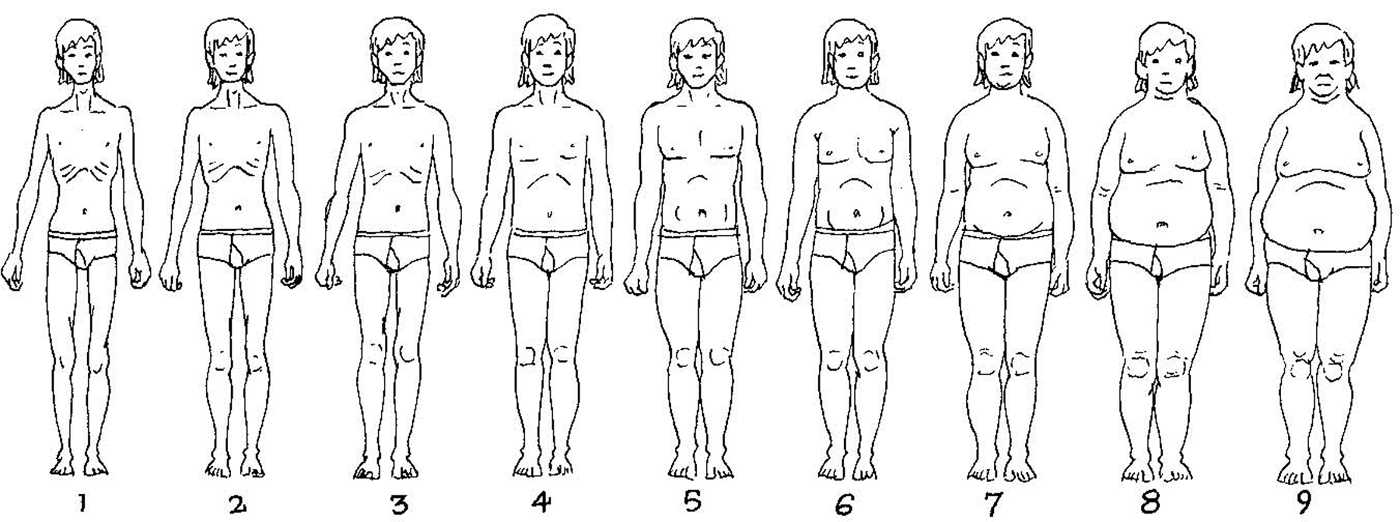
For this part of scoring your test, look at the difference between your responses to questions 1 and 2. Just count how many bodies are between the ones you picked; don’t worry about the direction.
If the difference between your answers is:
6 or 7 bodies: We have some work to do. So put 0 in the Body Score box in Introduction.
5 bodies: Give yourself 3 body score points in the box at the end of this section.
4 bodies: Give yourself 6 body score points in the box at the end of this section.
3 bodies: Give yourself 9 body score points in the Body Score box below.
2 bodies: Give yourself 12 body score points in the Body Score box below.
1 body: Give yourself 15 body score points in the Body Score box below.
0 body: Give yourself 18 body score points in the Body Score box below.
Picked the same body for both: Congratulations! Give yourself 21 body score points in the Body Score box.
Answer these four questions about your face and skin:
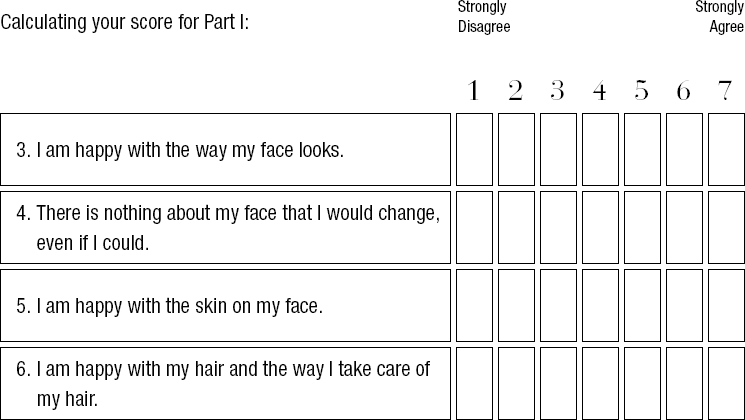

Your raw score can range from a low of 4 to a high of 49.
Your Looking Beautiful Raw Score
The scales in this section reveal about how happy you are with your overall appearance, focusing on your face and body. Find the range for your score on the Looking Beautiful test analysis below. After you read what scores in that range mean, write down the number of YOU-Q points you get for this score in the YOU-Q worksheet at the end of the section.
If Your Raw Score Is
4–18
There’s a lot about your appearance that bothers you. You probably feel bad whenever you look in the mirror. It will take a lot of work to change your appearance, but there are many things you can do to improve your body, face, hair, and skin.
19–30
You don’t feel like putting a paper bag over your head, but you also aren’t thrilled with the way you look. It may be that you want to change your body, or perhaps your face or your hair. We have a lot of suggestions that will help you improve the way you look, so it won’t be long before this score starts to go up.
31–39
Just because you may enjoy walking by a window to catch a glimpse of your reflection, that doesn’t mean that there aren’t a few changes you’d like to make. There are always things you can do to help maintain the beautiful you and to protect it from bad habits, the sun, and age.
40–49
Frankly, we’re surprised you had time to fill out this survey between modeling gigs. All we can say to you is, stay out of the sun, wear your seat belt, keep your feet on the ground, and keep reaching for the stars.
Part II: Feeling Beautiful
The questions in this section focus on how you feel physically.

Calculating your score for Part II:

Your raw score can range from a low of 4 to a high of 28.


